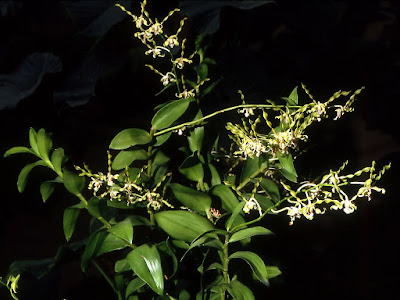Dendrobium strebloceras is native to the Malaysian archipelago. They are found in the Moluccas islands, the island of Halmahera, the Seram island...
Dendrobium strebloceras also called as The Twisted Horn Dendrobium, Callista strebloceras, Ceratobium strebloceras, Dendrobium dammerboerii, is a species of the genus Dendrobium. This species was described by Heinrich Gustav Reichenbach in 1886.
IDENTIFY DENDROBIUM STREBLOCERAS
Dendrobium strebloceras is native to the Malaysian archipelago. They are found in the Moluccas islands, the island of Halmahera, the Seram island.
It is a sympodial, large sized, hot growing epiphyte, which reaching 60-150 cm high, with shiny, yellow green, cane-like, tapering, 60-150 cm long stems that have a dark ring around each internode and carrying many, variable shaped, leathery, dark green, curved, 15 cm long leaves that are held at the upper 1/3 of the cane.
The Twisted Horn Dendrobium blooms in the summer and fall, on a 45 cm long, horizontal, 5 to 12, fragrant flowered, racemose inflorescence that is longer than the leaves and arises from the uppermost nodes. The flowers are 5 cm long. The petals of both whorls may be pale yellow or brownish-orange. The curved flakes of the outer whorl are twisted and wavy along the edge. They have 5 brown nerves marked. The twisted flakes of the inner whorl are usually stiff straight, but they can be at an angle. White to yellow lip has 5 purple bulges and purple edges. The middle plot has undulating edges. A single flower can last for 2 months and has a tendency to darken over time.
This species may blooms several times a year. The plants often produce keiki, which can be separated and planted, even when their roots are relatively short.
DENDROBIUM STREBLOCERAS CARE AND CULTURE
Cultural information should only be used as a guide, and should be to be adapted to suit you. Your physical location; where you grow your plants, how much time you have to devote to their care, and many other factors, will need to be taken into account. Only then can you decide on the cultural methods that best suit you and your plants.
Light:
Dendrobium strebloceras needs a light level of 25000-35000 lux.
Temperature:
The average temperature throughout the year is 29-31 ° C, night 24-25 ° C, and the daily difference is 4-7 ° C. A minimum winter temperature of 15 ° C is recommended.
Humidity:
The Twisted Horn Dendrobium needs the average humidity of around 80% throughout the year.
Substrate, growing media and repotting:
Dendrobium strebloceras can be grown mounted or planted in cortex or any other loose, quickly drying substrate. Repotting can be done at any time when new roots are growing.
Watering:
Precipitation is moderately abundant for most of the year, but during 2-3 months at the end of summer and at the beginning of autumn are slightly smaller. The plants should be evenly moist throughout the year, but at the end of summer and early autumn the amount of water should be reduced and the plants should be allowed to lightly dry between waterings.
Fertilizer:
It is recommended to apply weekly or every two weeks 1/4-1/2 doses of balanced fertilizer to orchids throughout the year.
Rest period:
In winter, you can slightly reduce the amount of water, especially if the Dendrobium strebloceras are grown in the conditions of a short, dark day prevailing in winter, but they can never dry out completely between waterings.















COMMENTS